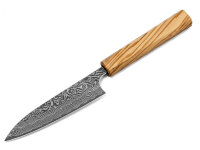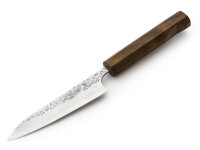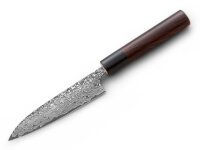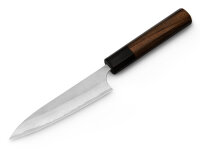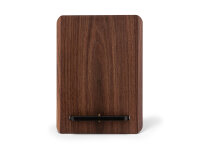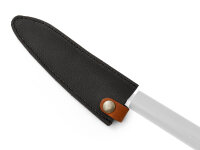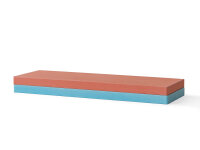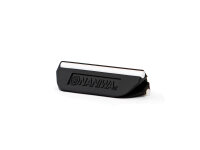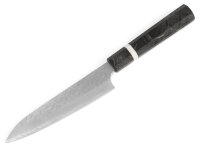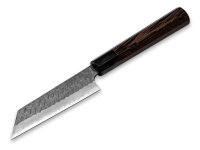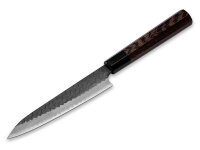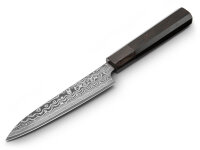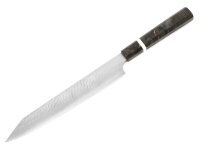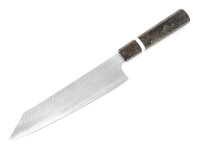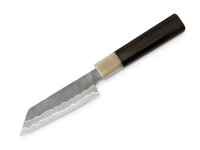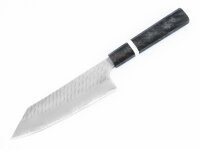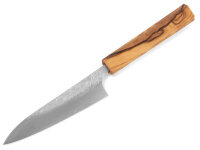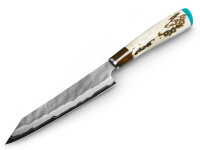"Paring knife SPG2 Migaki Tsuchime Kiritsuke 95, birchwood"
Nigara Hamono - Since the days of the samurai
The sword and knife forge Nigara Hamono can look back on a tradition of over 350 years. During the early Edo period, the city of Hirosaki was a castle town. There were over a hundred blacksmiths in the area at that time. Nigara Forging is one such historic forge in Tsugaru, north of Hirosaki, which has preserved and cultivated its craftsmanship to this day. The forging techniques used by Nigara are essentially the same as traditional blacksmithing, which has been used for centuries to produce high-quality sword and knife blades. The folding and hammering of soft iron and steel creates a distinctive beauty in every knife that Nigara produces.
Kuroshiage Tsuchime knife series from Nigara
This knife series is already something very special due to its origin, the Nigara forge. Visually, it is characterized by the Kuroshiage design and the striking hand hammering. However, the full character of the knives is only revealed when you use them in your kitchen. The knives have a very good, balanced weight distribution, are thinly forged and very sharp. The hard steel of the cutting core, forged to approx. 62 HRC, offers excellent sharpening potential. Manufacturer of the steel Takefu, Japan. Depending on the translation, the steel is also referred to as SGP2, Super Gold Powder 2. This steel is an absolute premium steel that is very expensive and difficult to obtain even in Japan. It is a powder metallurgical high-performance steel with a very fine structure. The high carbon content of 1.3% makes it extremely hard, so that up to 63 HRC are possible. Other components are 15% chromium, 3% molybdenum and 2% vanadium. With this cutting core, the knives in the series offer exceptionally high sharpness, cutting performance and durability and even outperform the premium steel VG-10.
Instructions for use
Japanese chef's knives are made from extremely hard steels and are forged and ground thinner than their European counterparts. Some of these knives have very finely ground cutting edges, making them more delicate and only suitable for soft cuts. Please note the relevant information in the product details. Knives with a very thin cutting edge and hollow grind are particularly prone to chipping on the blade. These are ideal for fine cuts of soft food, but should be used with appropriate care. Sharpening on a whetstone usually produces an angled grind, which makes the cutting edge more stable over time.
Chipping on the cutting edge can also be caused by leverage and frozen cuttings, which significantly reduce the temperature of the steel. Leverage forces often occur when cutting material with bones, for example. Chips on the cutting edge may need to be ground out by a specialist.
The knife should always be guided in a straight line with a pulling or pushing cut, without applying great pressure. To maintain sharpness, avoid cutting on stone, glass or other hard surfaces. Never use \"sharpening steel\" for resharpening. We recommend using water whetstones (grit: 400-1200 for pre-sharpening, 3000 for fine sharpening, 6000 or more for honing the blade) and a honing leather if necessary.
Please keep the knife away from children. These knives are extremely sharp, please be careful.
All products are unique, slight deviations from the exemplary illustration are therefore possible.
Care instructions
When using knives made of sensitive steel types, such as Aogami, Shirogami or V-Toku, please clean them occasionally with a cloth and water, even during prolonged use. However, acidic foods can still cause discoloration on these classic carbon steels. After use, please wash by hand with hot water and use a neutral detergent if necessary. Never put the knife in the dishwasher. After cleaning, dry thoroughly, oil if necessary and store in a well-ventilated place. Residual moisture can cause rust on non-stainless steels. Please refer to our articles in the ORYOKI Japan blog on product care.
Clean the knife by hand and do not use a dishwasher. Dry it thoroughly afterwards.

